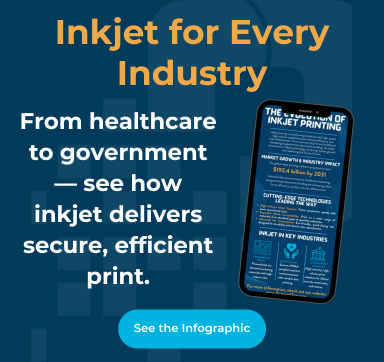It’s coming up on cold and flu season, and many of us are lining up to get preventive maintenance: a flu shot. Preventive maintenance is how most things are maintained and serviced—from human bodies to household appliances. In anticipation of mechanical parts breaking or needing repairs, we schedule service. Oil changes, annual HVAC assessments, and annual wellness exams are all examples of preventative maintenance. We hope that periodically checking the status of a piece of equipment will alert us to upcoming failure, reducing the amount of equipment downtime and the cost of repairs.
What if there was a better way to approach maintenance? What if the whole idea, essentially, could be turned around? And machines could inform us that they’re approaching the need to be serviced or, worse, approaching end of life?
Welcome to the future: Industry 4.0, or the fourth industrial revolution, as it’s sometimes called. Connected smart devices are making scenarios like the one described a reality, and they’re completely changing the way maintenance work is done thanks to the Internet of Things (IoT). IoT is a network of connected devices that can communicate with each other over the internet without needing a human or another computer to initiate the conversation. Because IoT connects to several technologies, it’s evolving every day, getting smarter due to real-time analytics, machine learning, artificial intelligence (AI), and embedded systems.
Chances are, you use a device that’s connected to IoT all the time. Do you talk to your smartphone, a smart speaker, or other smart appliances? A thermostat or doorbell, perhaps? You might speak to an IoT device, but they also talk to each other, and they learn from the data they collect.
Data-driven Maintenance
IoT-connected equipment is getting smarter, too, for the mere fact that it’s connected to the ever-evolving Internet of Things. When it comes to IoT-connected devices and maintenance, equipment is learning to collect and analyze its data and using tools like machine learning and artificial intelligence (AI) to predict when it needs service. For example, instead of getting a flu shot to prevent your body from catching the flu, your body would analyze its immune system, alert you to any weaknesses, and let you know your odds of getting sick. In the world of machinery, predictive maintenance (PdM) tools inherent in devices (sensor measurement involved in data collection and vibration analysis) alert users to a report that indicates the machine needs maintenance. Related to predictive maintenance programs is condition-based maintenance (CbM), which relies on real-time sensor measurements. CbM is unlike PdM in that work is performed when parameters reach unacceptable levels.
Both predictive maintenance and condition-based maintenance decrease the need for scheduling regular work orders and maintenance activity. They reduce maintenance costs by keeping repairs to only when they’re needed and eliminate the need for keeping unnecessary spare parts on hand. Customers benefit from the increased uptime, the proactive service, and the peace of mind that comes with knowing their equipment is always in top condition.
PdM & CbM in MFP
That string of acronyms means that there are multifunction printers (MFPs) optimized with predictive maintenance (PdM) or condition-based maintenance (CbM) tools. The fourth industrial revolution is driving business technology forward, and brand leaders are making sure they’re staying competitive with new maintenance features.
Canon
Canon has a line of maintenance tools called imageWare Enterprise Management Console (iW EMC), which work in conjunction with another tool Canon provides called Embedded Remote Diagnostic System (eRDS). These maintenance tools work together to allow for management for Canon devices. The browser-based network management tool allows for:
- retrieving and distributing device settings.
- rebooting machines remotely.
- reading meters.
Konica Minolta
Konica Minolta offers a new predictive maintenance service called bizhub vCare. Bizhub vCare:
- uses cloud services like machine learning and IoT to diagnose and maintain its MFPs.
- has Miercom Certified Secure accreditation and was one of the first companies to obtain this prestigious certification.
- ensures no prominent vulnerabilities were found in the server, engines, or other critical parts.
- features automatic meter reads that are delivered on-time via a monthly bill.
Using cloud services inherent in the IoT like machine learning and artificial intelligence, bizhub vCare is remotely diagnosing MFPs to a wide range of error messages or other alerts.
Kyocera
Kyocera uses Azure, a cloud computing service by Microsoft, to provide predictive maintenance services to customers. Through Azure, they were able to comply with ISO 27018—inherent in Azure—before any other company was doing so, and security and compliance has remained a top priority in their maintenance offerings ever since. Kyocera’s maintenance system is called Kyocera Fleet Services (KFS) and provides robust offerings such as:
- checking consumable levels.
- performing remote maintenance, diagnostics, and troubleshooting.
- generating lists and graphical reports.
- upgrading firmware and managing firmware packages.
KFS has four components to check on and perform maintenance: KFS Manager, KFS Device, KFS Gateway, and FKS mobile. Users can use their desktops, smartphones, or tablets to check their devices using one of the components listed.
Xerox
Xerox has a maintenance solution called ConnectKey Technology that allows users to customize how they want to use their MFPs and how they want to automate business functions. ConnectKey Technology can:
- manage, print, and scan documents using cloud technology.
- customize apps streamlining workloads.
- create electronic documents (i.e. custom EMRs or other records).
Xerox ConnectKey Technology can also integrate into a managed print hub that customers may already be utilizing, providing the user with a tablet-like interface, enhanced security, and optimized tools—all that can be managed remotely or on-premises.
Future of Smart Maintenance
Businesses are just beginning to scratch the surface of what predictive maintenance can do, and it’s evolving all the time as they get feedback from customers and the IoT continues to learn. If predictive maintenance is something you’re interested in, but you’re not sure where to get started, look no further than your friendly team at SumnerOne. They’ll be happy to walk you through the options on all the multifunction printers, evaluate your business needs, and help you decide what the right fit is. It will be a heck of a lot more fun than getting a flu shot.
 FREE EBOOK DOWNLOAD
FREE EBOOK DOWNLOAD
















